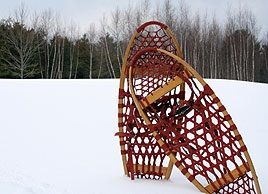Snowshoeing for fun and fitness
Across Canada, women are discovering snowshoeing as a fun way to stay fit. Find out how to get started

Source: Best Health Magazine, January/February 2009
Crunch. Crunch. Crunch. The snow in the stand of towering red pines near my home in Ignace, Ont., a couple of hundred kilometres northwest of Thunder Bay, is firmly packed by the wind, and every step my husband and I take in our snowshoes echoes in the cold still air. Behind me, the setting sun is painting the sky with streaks of pink and orange, and ahead of me the brilliant moon is just visible through the trees. As I pause to check out some unusual tracks’an otter has apparently been sliding down the pristine snowbanks’puffs of my frozen breath hang in the air. It’s bitterly cold, but I’m grinning and toasty warm. Snowshoeing trumps my couch-potato tendencies every time.
Snowshoeing: It’s a great workout
I’m not alone in my love for snowshoeing. Its popularity has soared in the last decade, and it’s not hard to see why: It’s fun, it’s easy, it’s relatively inexpensive and it burns up to 750 calories an hour. That’s about the same as an hour of jumping rope, and more than twice as much as walking.
“Snowshoeing is an absolutely fantastic cardio workout,” agrees Catherine D’Aoust, a Vancouver personal trainer who leads women’s snowshoeing classes as well as hikes. “This puts good stress on your heart. It’s also a low-impact activity, and your muscles and joints are stressed in different ways so you don’t get the overuse injuries that you might get running or playing tennis.” As well, snowshoeing is a killer lower-body workout. Walking in snow is tough, so it works the muscles in the legs and butt.
Snowshoeing gear
Part of the reason snowshoeing is hot is because the gear has been modernized. Today’s products are slender and light, with easily adjustable bindings, and have high-tech aluminum plastic or carbon fibre frames that are designed to fit a woman’s shorter gait and narrower foot. Metal crampons’which are basically “teeth” on the underside of the shoe’provide traction and stability.
“A snowshoe eight inches [20 cm] wide and 25 inches [64 cm] long will support a person between 120 and 180 pounds,” notes D’Aoust. She suggests renting snowshoes’available at outdoor recreation stores or winter recreation centres such as ski resorts’a few times to find a style that feels comfortable. When you’re ready to buy, expect to pay $100 to $150 for a decent pair of recreational snowshoes designed for groomed trails and moderate terrain. Snowshoes designed for mountaineering and backcountry treks are bigger, with heavy-duty bindings and larger crampons, and will cost more.
“People are always surprised at how easy it is to snowshoe. Within minutes of putting them on, you’re comfortable with the movement,” says D’Aoust. “And it’s really a good time. It’s great to see the women in my classes who are in their 30s and 40s giggling like teenagers.”
It’s not just walking
There’s also snowshoe running’a new high-energy offshoot of the sport, featuring even smaller, lighter snowshoes used with regular running shoes and often done on groomed trails. Says Sara Montgomery, 37, of Yarker, Ont.: “I’ve been doing trail running for quite a few years, so when I heard about snowshoe running I decided to give it a try. I was hooked the first time out. It’s a great way to add a different element to your training, plus it’s just fun to get out and play in the snow!” Today she competes in snowshoe races in Canada and the United States.
Which only proves that snowshoeing is nothing if not versatile. You can go on a quiet tramp with your family to watch wildlife in a local park, book a girlfriends’ spa weekend where the trail ends with fondue and a massage, or embark on a challenging backcountry trip. (Visit trailpeak.com to find out about the variety of trails and activities in your area.)
Come on, ladies’Canadian winters are just too long and snowy to hibernate indoors!
A Canadian tradition
I have to confess: As appealing as these new snowshoes are, I’m old school; my traditional wood-and-rawhide snowshoes suit me just fine. The craftsman who made them chose the Ojibwa style, which perfectly suits the deep snow and thick brush of northern Ontario. They’re quite different from the wide, tennis-racquet-like Huron or Maine style that comes to mind when most people think of snowshoes. Custom-made for my mother-in-law nearly 40 years ago, my snowshoes are long, slim and elegant, tapering to a graceful point at either end. It pleases me to stomp around in the same type used by the explorers, pioneers and First Nations peoples before me.
‘Bonnie Schiedel
This article was originally titled "Blazing a Trail," in the January/February 2009 issue of Best Health. Subscribe today and never miss an issue!




